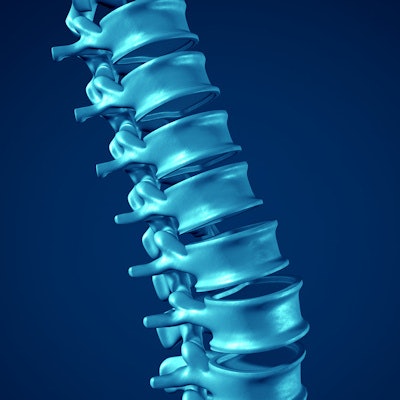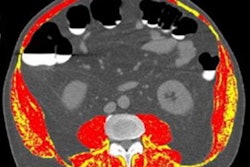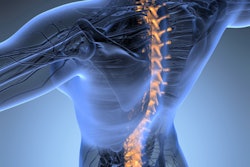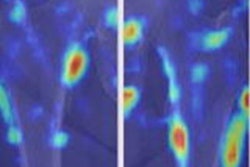
Making use of 3D radiomics features, an artificial intelligence (AI) algorithm can opportunistically screen for osteoporosis on lumbar spine CT images, according to research published online April 8 in BMC Musculoskeletal Disorders.
Researchers from Shanghai Jiao Tong University in Shanghai, China, developed a predictive model based on radiomics analysis and machine-learning algorithms. In testing, the best-performing model yielded an area under the curve (AUC) of 0.994 for differentiating normal bone density and osteoporosis on lumbar spine CT.
"The excellent performance of this radiomic model indicates that lumbar spine CT images can effectively be used to identify osteoporosis and as a tool for opportunistic osteoporosis screening," the authors wrote.
Bone mineral density is most commonly assessed on dual-energy x-ray absorptiometry (DEXA) exams. However, DEXA has its inherent limitations, and it is insufficient to determine bone strength, according to the researchers.
"Therefore, a clinically feasible tool is urgently needed to improve the diagnosis of osteoporosis in the spinal region," the authors wrote.
In lumbar CT exams, radiomics features from vertebral images aren't susceptible to variance in image acquisition, reconstruction, segmentation, and data modeling, according to the researchers.
"This image processing approach is reproducible, repeatable, and robust and is expected to improve diagnostic accuracy," the authors wrote.
As a result, the researchers sought to explore the utility of radiomics features on lumbar spine CT exams to distinguish osteoporosis from exams with normal bone density.
They first retrospectively gathered data from 133 patients, including 53 with normal bone mineral density, 32 with osteopenia, and 48 with osteoporosis. The SenseCare advanced visualization research platform (SenseTime) was used to automatically segment the L1-L4 vertebrae on the CT images. The researchers then extracted 1,197 radiomic features from these regions of interest using the open-source PyRadiomics software.
After logistic regression and Pearson correlation coefficient matrices were used to select the most significant features, the researchers then developed three classification machine-learning models based on the random forest, support vector machine, and k-nearest neighbor algorithms.
They then performed fivefold cross-validation to quantify the algorithms' ability to discriminate between normal bone mineral density, osteopenia, and osteoporosis on the dataset. The random-forest model yielded the best performance.
| Best machine-learning model in differentiation tasks | |||
| Normal bone mineral density vs. osteopenia | Osteopenia vs. Osteoporosis | Normal bone mineral density vs. osteoporosis | |
| AUC | 0.940 | 0.940 | 0.994 |
The algorithm's strong discriminatory performance show that radiomic features from lumbar spine CT exams can be used as a biomarker for predicting osteopenia and osteoporosis, according to the researchers.
"For patients who undergo lumbar CT, the radiomic features extracted from L1–L4 could be used as a tool for opportunistic osteoporosis screening," the authors wrote. "This image processing method is simple to implement and cost-effective, poses no additional radiation hazard, and may serve as a substitute for DXA."
The researchers noted that their algorithm needs to be tested now on larger and multicenter datasets.
"Including clinical risk factors (e.g., age, sex, and BMI) may also help improve the model's performance as a predictor of bone mineral loss," they wrote.




















